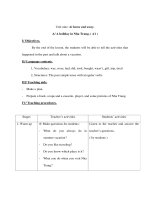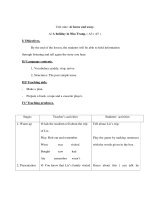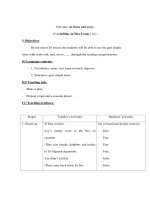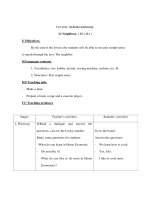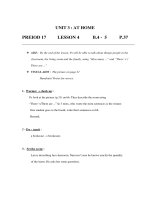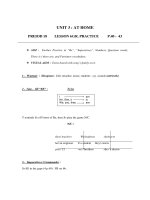pushes and pulls at home
Bạn đang xem bản rút gọn của tài liệu. Xem và tải ngay bản đầy đủ của tài liệu tại đây (1.92 MB, 19 trang )
A Procedural Text
by Kendall Kramer
Pushes and
Pulls at Home
Pushes and
Pulls at Home
Write About
Pushes and Pulls
A Procedural Text
by Kendall Kramer
Pushes and
Pulls at Home
Pushes and
Pulls at Home
A force can be a push or a pull. A push
or a pull can move things.
You can investigate pushing and
pulling at home.
2
Here is a checklist you can use when
you investigate.
Pushes and Pulls
at Home
Ask a Question
Predict
Plan
Observe
Record
Analyze Data
Draw a Conclusion
Share Results
3
Do I use more
pushes or
pulls at
home?
Ask a Question
Start with a science question.
4
5
Predict
Think about the things you push and pull
every day. Then make a prediction.
Pushes and Pulls
at Home
My Question
Do I use more pushes
or pulls at home?
My Prediction
I use the same number
of pushes and pulls in
one day.
6
Plan
Plan a fair way
to answer your
question.
7
I pushed a toy car.
I pushed a book onto a shelf.
I pushed the doorbell.
I pushed a drawer shut.
Observe
Observe the pushes you use. Write down
the objects you push.
8
I pushed some buttons.
I pushed a cabinet door.
I pushed a chair.
Things I Push Things I Pull
doorbell
toy car
book
drawer
cabinet door
buttons
chair
9
I pulled my shoelaces to tie them.
I pulled a wagon.
Observe the pulls you use. Write down
the objects you pull.
10
I pulled up the covers.
I pulled a drawer open.
I pulled a chain.
Things I Push Things I Pull
doorbell shoelaces
toy car wagon
book covers
drawer drawer
cabinet door chain
buttons
chair
11
Record
Make a table like
this one. It needs
three columns and
enough rows to list
all of the objects.
Write down all the
pushes and pulls
from the day.
12
Object Push Pull
book X
buttons X
cabinet door X
chair X
covers X
doorbell X
drawer X X
light switch
chain
X
shoelaces X
toy car X
wagon X
13
Analyze Data
Add up the pushes and pulls.
Check your prediction.
Object Push Pull
book X
buttons X
cabinet door X
chair X
covers X
doorbell X
drawer X X
light switch
chain
X
shoelaces X
toy car X
wagon X
Total: 7 5
14
push
pull
Draw a Conclusion
See whether you used more pushes
or pulls. Did you ever push and pull
the same object?
15
Share Results
Show your table to the class.
Tell them what you found out
about pushes and pulls you
use at home.
16
Author’s
Note
When my science teacher
gave us our homework,
I couldn’t wait to start
observing. My family helped
me look around for things to
push and pull. I didn’t realize
how many objects I pushed
and pulled every day.
After I finished the
investigation, I wrote about
the procedure I followed. I
read it to my little sister last
night. It was a fun way to
share my experience.
— Kendall Kramer
Acknowledgments
Grateful acknowledgment is given to the authors, artists, photographers, museums, publishers,
and agents for permission to reprint copyrighted material. Every effort has been made to secure
the appropriate permission. If any omissions have been made or if corrections are required,
please contact the Publisher.
Illustrator Credits
Shawn McKelvey
Neither the Publisher nor the authors shall be liable for any damage that may be caused or
sustained or result from conducting any of the activities in this publication without specifically
following instructions, undertaking the activities without proper supervision, or failing to comply
with the cautions contained herein.
Program Authors
Malcolm B. Butler, Ph.D., Associate Professor of Science Education, University of South Florida,
St. Petersburg, Florida; Judith Sweeney Lederman, Ph.D., Director of Teacher Education and
Associate Professor of Science Education, Department of Mathematics and Science Education,
Illinois Institute of Technology, Chicago, Illinois; Randy Bell, Ph.D., Associate Professor of Science
Education, University of Virginia, Charlottesville, Virginia; Kathy Cabe Trundle, Ph.D., Associate
Professor of Early Childhood Science Education, The Ohio State University, Columbus, Ohio; Nell
K. Duke, Ed.D., Co-Director of the Literacy Achievement Research Center and Professor of Teacher
Education and Educational Psychology, Michigan State University, East Lansing, Michigan; David
W. Moore, Ph.D., Professor of Education, College of Teacher Education and Leadership, Arizona
State University, Tempe, Arizona
The National Geographic Society
John M. Fahey, Jr., President & Chief Executive Officer
Gilbert M. Grosvenor, Chairman of the Board
Copyright © 2011 The Hampton-Brown Company, Inc., a wholly owned subsidiary of the National
Geographic Society, publishing under the imprints National Geographic School Publishing and
Hampton-Brown.
All rights reserved. No part of this book may be reproduced or transmitted in any form or by
any means, electronic or mechanical, including photocopying, recording, or by an information
storage and retrieval system, without permission in writing from the Publisher.
National Geographic and the Yellow Border are registered trademarks of the National
Geographic Society.
National Geographic School Publishing
Hampton-Brown
www.NGSP.com
Printed in the USA.
RR Donnelley, Johnson City, TN
ISBN: 978-0-7362-7672-6
10 11 12 13 14 15 16 17
10 9 8 7 6 5 4 3 2 1
Writing Procedural
1


